(广州版)五年级英语下册课件 Module 1 Unit 3(1)
- 格式:ppt
- 大小:2.56 MB
- 文档页数:12
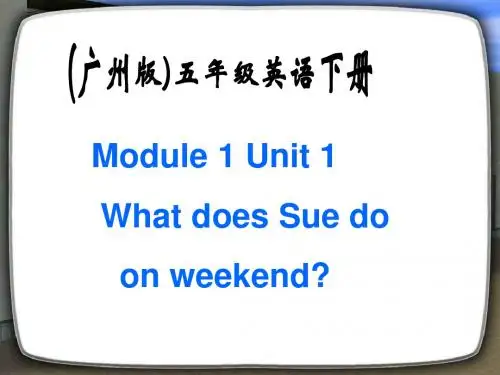
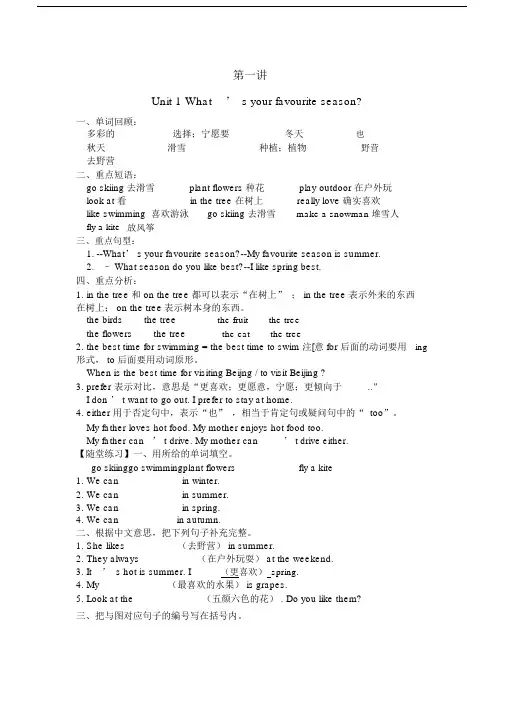
第一讲Unit 1 What’ s your favourite season?一、单词回顾:多彩的 ________选择;宁愿要_______冬天________也_________ 秋天 _________滑雪___________种植;植物_______野营_______ 去野营 _________二、重点短语:go skiing 去滑雪plant flowers 种花play outdoor 在户外玩look at 看in the tree 在树上really love 确实喜欢like swimming 喜欢游泳go skiing 去滑雪make a snowman 堆雪人fly a kite 放风筝三、重点句型:1.--What’ s your favourite season?--My favourite season is summer.2.– What season do you like best?--I like spring best.四、重点分析:1.in the tree 和 on the tree 都可以表示“在树上” ; in the tree 表示外来的东西在树上; on the tree表示树本身的东西。
the birds ___ the tree the fruit ___ the treethe flowers ___ the tree the cat ___ the tree2. the best time for swimming = the best time to swim 注[意 for 后面的动词要用ing 形式, to 后面要用动词原形。
When is the best time for visiting Beijng / to visit Beijing ?3. prefer 表示对比,意思是“更喜欢;更愿意,宁愿;更倾向于..”I don ’ t want to go out. I prefer to stay at home.4.either 用于否定句中,表示“也” ,相当于肯定句或疑问句中的“ too”。
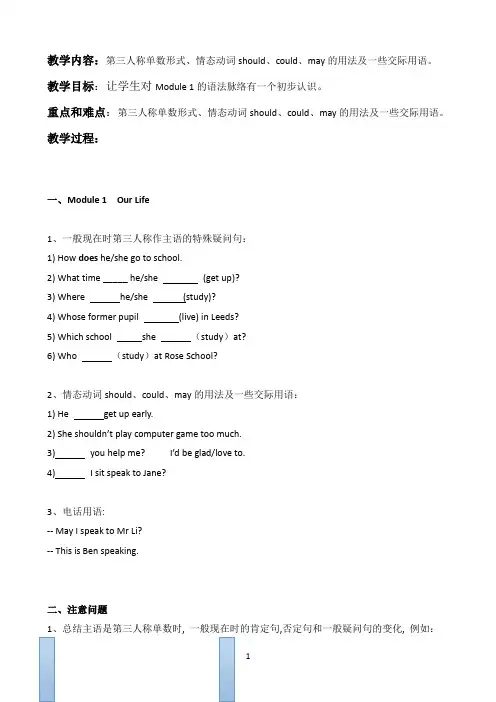
教学内容:第三人称单数形式、情态动词should、could、may的用法及一些交际用语。
教学目标:让学生对Module 1的语法脉络有一个初步认识。
重点和难点:第三人称单数形式、情态动词should、could、may的用法及一些交际用语。
教学过程:一、Module 1 Our Life1、一般现在时第三人称作主语的特殊疑问句:1) How does he/she go to school.2) What time _____ he/she (get up)?3) Where he/she (study)?4) Whose former pupil (live) in Leeds?5) Which school she (study)at?6) Who (study)at Rose School?2、情态动词should、could、may的用法及一些交际用语:1) He get up early.2) She shoul dn’t play computer game too much.3) you help me? I’d be glad/love to.4) I sit speak to Jane?3、电话用语:-- May I speak to Mr Li?-- This is Ben speaking.二、注意问题1、总结主语是第三人称单数时, 一般现在时的肯定句,否定句和一般疑问句的变化, 例如:I eat dinner at six. He eats dinner at six .I don’t eat dinner at six. He doesn’t eat dinner at six . Do you eat dinner at six? Does he eat dinner at six?2、总结主语是第三人称单数时, 一般现在时的特殊疑问句形式, 如:What time does he get up? He gets up at six.Where does she live? She lives in Renmin Road.How does he go to work?He goes to work by bus.Who hands in the homework? Jiamin does.Whose friend practices the piano? Jane’s friend practices.Which school does she study at ? She studies at No. 2 School?3. 当主语是第三人称单数时, 一般现在时的动词的变化的规律:1) 一般情况加-s,例如:visit – visits tell – tells work – works wave – waves2) 以s, x, sh, ch结尾的动词, 加-es,例如:wash – washes watch – watches catch – catches3) 以辅音字母加y结尾的动词,改y为i加-es,例如:fly – flies study – studies4) 部分以o结尾的动词加-es,例如:go – goes do – does5) 特殊情况have – has4、小练习1)用所给的词的适当形式填空.○1.Let him _____(play)basketball.○2.Everyone_____(know)what he really like.○3.Tose girls____(be)my sister.○4.That girl_____(call)me evety Sunday.○5.How___(do)she_____(spell)the word?2)否定句:在动词前+doesn't或don't.○1.She_____ _____(do)her homework every day.○2.He_____ _____(live)in Huanggang.○3.He_____ _____(need)a pair pf shoes.○4.Danny_____ _____(see)the apple tree?○5.She_____ _____(come)from America.○6.The girl_____ _____(look)out of the window and sees many bieds in the sky. ○7.Jenny runs home and_____ _____(sit)on the chair.3)一般疑问句:○1._____the desk_____(have)four legs?Yes,it does.○2._____she____(do)her homework every day?Yes,she does.○3._____he_____(live)in Huanggang?No,he doesn't.○4._____he_____(need)a pair of shoes?NO,he doesn't.○5.Does Danny_____(see)the aoole tree?○6._____she_____(come)from America?Yes,she_____.○7._____the girl_____(look)out of the window and sees many birds in the sky? No,she_____.○8._____Jenny runs home and_____(sit)on the chair?三、Unit 11、for an hourfor 表示时间的长度,例如:for two year_____ ____ 半小时______ _____ 一个半小时2、注意句型:Could you …?I’d be glad to. / I’d love to.3、比较级句型:She is older than me.She is one year older than me.4、守规律;守规则四、Unit 21、电话用语:May / Could / Can I speak to …This is … speaking. / Speaking.Wh o’s this / that?2、He looks________(tall) now than before. 他现在看起来比以前瘦很多。

广州版小学英语五年级下册Module 1 Our lifeUnit 3 Let’s Go Further一、Teaching Content:Module 1(Unit 3) Let’s go further二、Teaching aim:(一) Main Task:1. Can say these words correctly: sleepy, kid, more, boring, interesting, horrible, funny, either, asleep,2. Can read the dialogue fluently and correctly.3. Can use these daily expressions in communication:A. It’s boring/ horrible/ interesting.(二)Difficult point:1. New words of this dialogue.2. The comprehension of the dialogue of Unit3.(三)Affects:1. Learn how to keep good habits in both daily life andStudy.2. Learn how to study consciously.三、Teaching Tools: Computer, CD Rom (King Sun), projecting apparatus, the tape of the dialogue四、The time teachers need: 3 long-periods.五、Teaching Process:Leading-in1. Greeting2. Have them do the exercises about the simple present tense.1)Greeting2)do the exercises about the simple present tense. Review the old knowledge and the old sentences.Presentation1. Have Ps look at the pictures and say what they think the story will be about.2. Show the CD Rom(King Sun).Let them listen and watch carefully twice, try to understand what its meaning.3. Teach the new words. Sleepy, kid, more, boring, interesting, horrible, funny, either, asleep, Let them read by themselves in groups.4. Check their Pronunciation of the new words.5. The teacher read the dialogue and asks them pay attention to the pronunciation and intonation.6. Let them try to read the dialogue in pairs and read the dialogue one by one. The teacher corrects their pronunciation.7. Let them find out the sentences or the words which they couldn’t understand and then discuss in groups. The teacher helps them.Voluntarily.1. Look at the pictures and say what they hank the story will be about.2. Watch and listen the dialogue of Module 1, Unit 3 twice. Try to understand what its meaning.3. According the Phonetic symbol to learn these new words. Read by themselves in groups and speak.4. Read after the teacher and the tape.5. Listen to the teacher carefully.6. Try to read the dialogue in Paris and read the dialogue one by one. One for each sentence. 7.Find out the sentences or the words which they couldn’t understand and then discuss in groups.1) Learn the new content.2) Check and correct their pronunciation and intonation.3) Learn how to study and find out the questions by themselves.4) Go over the tense.Practice1. Ask them read the new words in groups, check and correct each other.2. Read the dialogue follows the tape. Read the dialogue in pairs.3. Read the new words in groups check and correct each other.4. Read the dialogue follows the tape. Read the dialogue in pairs. To help the pupils get more clear of the dialogue and d the words.Consolidate and Development1. Ask what we have learned at this section.2. Have Ps act out the dialogue.3. Answer the questions.4. Try to act out the dialogue.5. To help the pupils to get a clear idea of what they’ve learned and help them to learnsomething from this dialogue.Homework1. Read the new words and the dialogue after the tape and then read by them loudly and correctly.2. Try to tell the story to the parents.。

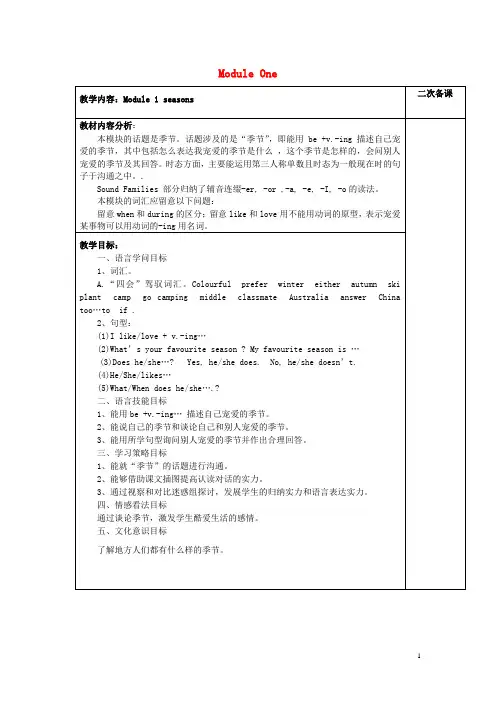


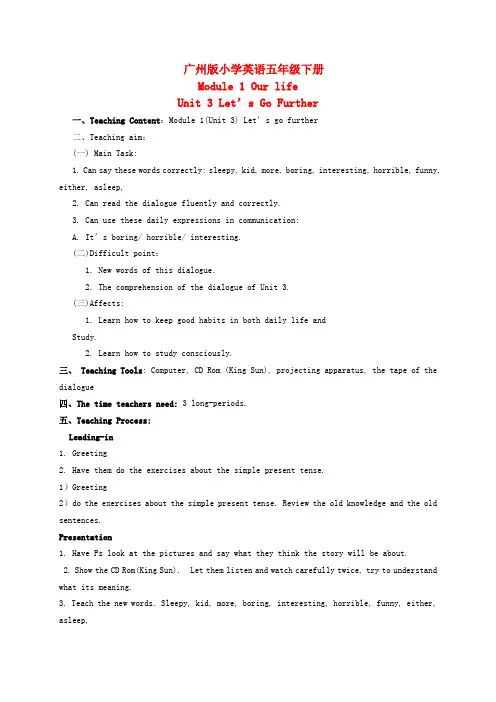
广州版小学英语五年级下册Module 1 Our lifeUnit 3 Let’s Go Further一、Teaching Content:Module 1(Unit 3) Let’s go further二、Teaching aim:(一) Main Task:1. Can say these words correctly: sleepy, kid, more, boring, interesting, horrible, funny, either, asleep,2. Can read the dialogue fluently and correctly.3. Can use these daily expressions in communication:A. It’s boring/ horrible/ interesting.(二)Difficult point:1. New words of this dialogue.2. The comprehension of the dialogue of Unit3.(三)Affects:1. Learn how to keep good habits in both daily life andStudy.2. Learn how to study consciously.三、 Teaching Tools: Computer, CD Rom (King Sun), projecting apparatus, the tape of the dialogue四、The time teachers need: 3 long-periods.五、Teaching Process:Leading-in1. Greeting2. Have them do the exercises about the simple present tense.1)Greeting2)do the exercises about the simple present tense. Review the old knowledge and the old sentences.Presentation1. Have Ps look at the pictures and say what they think the story will be about.2. Show the CD Rom(King Sun). Let them listen and watch carefully twice, try to understand what its meaning.3. Teach the new words. Sleepy, kid, more, boring, interesting, horrible, funny, either, asleep,Let them read by themselves in groups.4. Check their Pronunciation of the new words.5. The teacher read the dialogue and asks them pay attention to the pronunciation and intonation.6. Let them try to read the dialogue in pairs and read the dialogue one by one. The teacher corrects their pronunciation.7. Let them find out the sentences or the words which they couldn’t understand and then discuss in groups. The teacher helps them.Voluntarily.1. Look at the pictures and say what they hank the story will be about.2. Watch and listen the dialogue of Module 1, Unit 3 twice. Try to understand what its meaning.3. According the Phonetic symbol to learn these new words. Read by themselves in groups and speak.4. Read after the teacher and the tape.5. Listen to the teacher carefully.6. Try to read the dialogue in Paris and read the dialogue one by one. One for each sentence. 7.Find out the sentences or the words which they couldn’t understand and then discuss in groups.1) Learn the new content.2) Check and correct their pronunciation and intonation.3) Learn how to study and find out the questions by themselves.4) Go over the tense.Practice1. Ask them read the new words in groups, check and correct each other.2. Read the dialogue follows the tape. Read the dialogue in pairs.3. Read the new words in groups check and correct each other.4. Read the dialogue follows the tape. Read the dialogue in pairs. To help the pupils get more clear of the dialogue and d the words.Consolidate and Development1. Ask what we have learned at this section.2. Have Ps act out the dialogue.3. Answer the questions.4. Try to act out the dialogue.5. To help the pupils to g et a clear idea of what they’ve learned and help them to learn something from this dialogue.Homework1. Read the new words and the dialogue after the tape and then read by them loudly and correctly.2. Try to tell the story to the parents.。
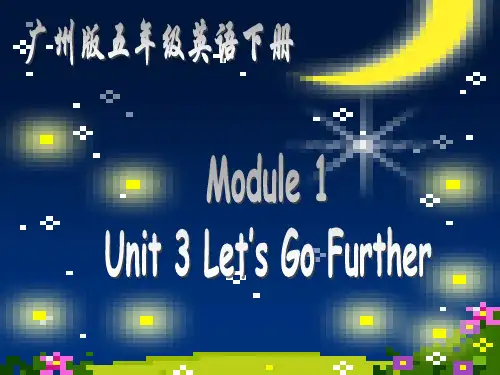
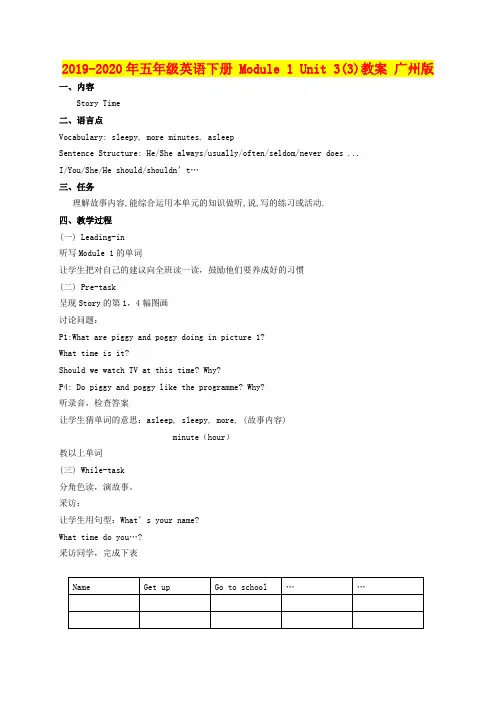
2019-2020年五年级英语下册 Module 1 Unit 3(3)教案广州版一、内容Story Time二、语言点Vocabulary: sleepy, more minutes, asleepSentence Structure: He/She always/usually/often/seldom/never does ...I/You/She/He should/shouldn’t…三、任务理解故事内容,能综合运用本单元的知识做听,说,写的练习或活动.四、教学过程(一) Leading-in听写Module 1的单词让学生把对自己的建议向全班读一读,鼓励他们要养成好的习惯(二) Pre-task呈现Story的第1,4幅图画讨论问题:P1:What are piggy and poggy doing in picture 1?What time is it?Should we watch TV at this time? Why?P4: Do piggy and poggy like the programme? Why?听录音,检查答案让学生猜单词的意思:asleep, sleepy, more, (故事内容)minute(hour)教以上单词(三) While-task分角色读,演故事。
采访:让学生用句型:What’s your name?What time do you…?采访同学,完成下表让学生根据采访结果, 仿照书“PROJECT”做一做, 写一写, 提醒学生要注意人称的变化及动词的变化抽查学生,并让他们读一读.,并根据所做情况小结.(四) Pro-task and Check做活动手册Unit 3的第1题先让学生把给出的答案读一遍听录音,做题目,教会学生要学会听关键词评讲做活动手册Unit3的第3题看图写出句子所缺的单词让学生读一读句子,注意动词词尾的发音让学生同位根据图画和句子,提出问题,并回答.总结(五) Homework完成活动手册unit3 第5题写写父母的日常生活第二课时一、内容Did you know?Additional wordsSelf-assessment二、语言点Vocabulary: chat, hurry, straight,Sentence Structure: He/She always/usually/often/seldom/never does ...I/You/She/He should/shouldn’t…三、任务能用所学知识完成课堂活动或练习四、教学过程(一) Leading-in评讲<<活动手册>>的作业(二) Pro-taskSing a song<Should, shouldn’t>根据歌词和实际,说说我们在课堂上哪些是应该做的,哪些是不应该做的(三) While-task呈现Additional words的图画判断should/shouldn’t呈现Additional words的句子猜猜单词chat, hurry, straight的意思.把句子与相应的图画连起来.呈现Did you know?的图画让学生用英语谈论图画的意思出示句子向学生介绍西方人日常生活中一些不应该做的事情让学生比较中西方在这些事情上的做法有什么相同与不同让学生小组讨论我们日常生活中哪些是应该做的,哪些是不应该做的.做<<活动手册>> unit 3的第4题找出关键词写出图的编号,并画出钟的时间检查答案做<<活>>unit3的第2题读一读题目所给的句子听录音,判断句子正误评讲答案, 要求学生说出错的原因做<<活>>unit3的第6题读短文分清e-mail的内容是写谁比较两封e-mail的内容,找出两者的相同点和不同点填表,评讲(四) Pro-task and Check完成Self-assessment总结学生的表现及本单元的主要内容(五) Homework仿照<<活动手册>> P13写一封e-mail给老师, 内容主要是关于自己的日常生附送:2019-2020年五年级英语下册 Module 1 Unit 3(4)教案广州版一、教学目标:进一步增强学生养成良好生活习惯和学习习惯的意识。